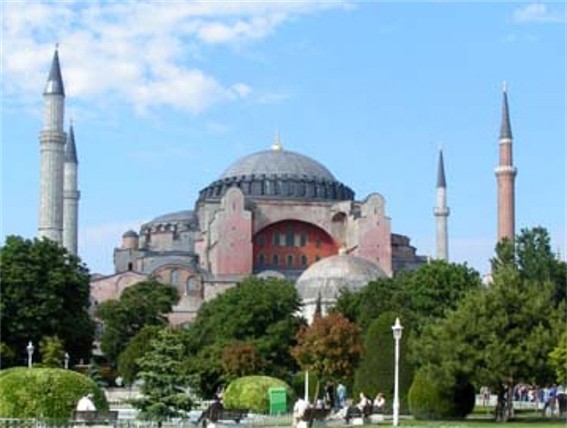Byzantine art
Byzantine art. Visual art produced in the Byzantine Empire and in countries under its political control or cultural influence, among them Ukraine. The spread of Byzantine art was the result, in large measure, of its style, which had all the traits of universalism to which other cultures could easily adapt. This style began to develop in the 6th century AD during the first Golden Age under the reign of Emperor Justinian. It was based on Greco-Roman art and the art of the East—Syria, Asia Minor, Persia, and Egypt. In architecture, churches with stone cupolas symbolizing the cosmos appeared, replacing the longitudinal basilicas with flat wooden ceilings. The Hagia Sophia Cathedral in Constantinople (dedicated in 537), with its huge cupola resting on four piers by means of pendentives, became the accepted standard for church architecture. In the 7th–9th century the cruciform church plan was developed. In this plan the main dome was surrounded by smaller domes, creating a large interior space without the use of buttresses to support the walls. Byzantine painting departed from Greco-Roman ideals, which prescribed three-dimensional illusionism in the reproduction of nature. Under the influence of Eastern art, it turned to a two-dimensional, flat representation. Some historians of the 19th century interpreted this as the barbarization of painting, with the return to Hellenic ideals only during the Renaissance. Yet, the replacement of realistic illusionism by symbolism under the influence of Christian ideas proved to be profoundly creative in that it rejected secondary detail and perspective and concentrated on the plastic depiction of an idea in its most immediate form. The content became more important than the form, and the background lost its perspective and became predominantly golden, emphasizing the play of lines and colored planes of strong tones and contrasts of light. All these features are elements of an essentially plastic nature, equally significant in all ages. Hence, Byzantine art developed creatively without losing its stylistic features when it was transferred to other lands, even after the decline of Byzantium as a cultural center.
In the 8th–9th century, after the defeat of the iconoclasts, the second Golden Age of Byzantine art began. It lasted through the reign of the Macedonian and Comnenian dynasties (869–1204). During this period Kyivan Rus’ actively entered the orbit of Byzantine culture and in 988 adopted Christianity through Byzantium (see Christianization of Ukraine). However, Byzantine influence on Ukrainian territory began much earlier and was concentrated on the northern shores of the Black Sea (see Ancient states on the northern Black Sea coast). In the 6th century Byzantine influence spread to Taurica (see Tavriia), where the city of Kerch in the Crimea was restored. At this time basilican and cruciform churches similar to those in Ravenna were built in Chersonese Taurica. After the hiatus caused by the Khazar invasion in the 7th century Chersonese resumed its development and maintained close relations with Kyiv. Prince Volodymyr the Great of Kyiv was baptized here in 988. There were up to 30 churches and chapels in old Chersonese, of which only the foundations remain today. Having annexed the Crimea in 1783, the Russian government, under the pretext of urban development, demolished the partially preserved early Christian buildings of Chersonese. The oldest known church there dated back to the 5th century and displayed the influence of Syrian architecture. The largest church was the so-called Uvarov Basilica (named after the discoverer, Aleksei Uvarov), whose three naves were similar to those in Ravenna and Balkan churches. Similar churches were discovered also in Kerch. The Church of Saint John the Baptist, built in Kerch in the 10th century, with a column dated 767 and Byzantine capitals from the 6th century, is the only fully preserved church of the first millennium in the Crimea.
Despite the destruction caused by the continual invasions of nomadic hordes, examples of art and architecture from the Princely era, particularly stone structures, have survived. Many icons and other artwork perished in fires, however. There were churches in Kyiv, such as Saint Elijah's Church, even before Christianity was officially adopted by Ukraine. However, these early temples were built of wood and were also destroyed by fire. Stone and brick architecture appeared in Ukraine under Byzantine influence, which brought to Kyiv such traditional techniques of Roman architecture as opus mixtum (alternating layers of brick and stone in the construction of walls). Kyivan architecture became the model for buildings in other cities of Kyivan Rus’. Although the Church of the Tithes from the end of the 10th century has not survived, the Saint Sophia Cathedral, begun in 1037, has been preserved in relatively good condition. The cathedral has a cruciform plan, with 5 naves and, originally, 13 domes. Apart from the general features of the Byzantine style, Saint Sophia of Kyiv does not resemble the Hagia Sophia of Constantinople, but rather bears a certain resemblance to the churches in Georgia.
The interiors of the early Kyivan churches are connected directly with the art of Chersonese Taurica. According to the Rus’ chronicles, Prince Volodymyr the Great imported the first architects and artists from Chersonese, and these together with the artists of Constantinople were the first creators of mosaics and frescoes. In style and chronology the mosaics of Saint Sophia Cathedral occupy a position between the mosaic complex of the monastery church of Hosios Lukas in Phocis, Greece (1020s) and the mosaics in the monastery church at Daphni near Athens (end of the 11th century). The style of the Kyivan mosaics is more archaic and closer to the mosaics of Hosios Lukas, while the mosaics of Saint Michael's Church of the Saint Michael's Golden-Domed Monastery in Kyiv (beginning of the 12th century) have already shed the archaic severity and are more lifelike. The interior of Saint Sophia basically adheres to the hierarchical ordering of paintings that was established in Byzantine art: Christ the Pantocrator was depicted on the dome ceiling; beneath him, four archangels; below them, the prophets and apostles; and at the bottom, the bishops or fathers of the Church. On the wall behind the altar the Mother of God (Orante) is depicted between the heavenly and the earthly Church, as if unifying the two. The arch of the sanctuary is framed with medallions portraying the martyrs. While the mosaics of Saint Sophia conform to all the traditions of Byzantium, the frescoes contain numerous innovations and departures from the Byzantine models, in depicting, for example, the Last Supper, the transformation of water into wine at the wedding in Cana. Apocryphal themes are reflected in the cycle of paintings devoted to the life of the Virgin Mary. Even in this early period Kyiv had its local iconographers who diverged in some ways from the mainstream of Byzantine art and followed their own inspiration in painting.
The Kyivan state maintained close relations with the Western countries. Hence, a certain exchange and intermingling of styles was inevitable. Halych and Chernihiv buildings, for example, possess elements of Romanesque architecture. The Western style is reflected also in some miniatures. Later, in the 15th–16th century, Galician iconography creatively absorbed certain features of the Gothic style, a rare occurrence in the history of Byzantine art.
At the turn of the 19th century some scholars, such as the Russian Byzantologist N. Kondakov, held that the Kyivan art of the Princely era was only a provincial imitation of the art of Constantinople. Since then much has been discovered and clarified. In 1957 A.M. Ammann showed that the art of Kyiv was of a metropolitan type, while the art of the northern territories of Rus’, which arose under Kyiv's influence, had a peripheral style. He notes that the fresco complexes that have been preserved in Kyiv had no parallels at the time in Constantinople and that the Kyivan mosaics preserved the oldest normative type of the Pantocrator and the Eucharist in Byzantine art. Because of constant invasions few icons of the Princely era (10th–14th century) have survived in Ukraine, but some excellent examples of Kyivan icons have been preserved in Russia; for example, the Mother of God from Vyshhorod (known as Vladimirskaia), Saint Demetrius, and the Mother of God with Saint Anthony and Saint Theodosius from the Kyivan Cave Monastery, are now in the Tretiakov Gallery in Moscow.
After the fall of Byzantium in 1457 Byzantine iconography continued to flourish. This can be seen in Galicia, where from the 14th to the end of the 16th century high-quality Ukrainian examples of icons in the Byzantine style were painted. Over the centuries this style was transformed and became organically Ukrainian. In the 17th and 18th century some of the finest examples of architecture in Ukraine appeared. They were a synthesis of Ukrainian folk architecture with the Byzantine and the baroque styles. Ukrainian wooden churches of that time are unparalleled masterpieces of world renown.
The Byzantine style was revived in Ukrainian art at the beginning of the 20th century. Mykhailo Boichuk combined Byzantine traditions with modern tendencies such as cubism and constructivism, producing one of the most important movements in East European art, the Neo-Byzantinism.
(See also Architecture, Enamel, Fresco painting, Icon, Miniature painting, Mosaic, Painting, Neo-Byzantinism, and Sculpture.)
BIBLIOGRAPHY
Prakhov, A. Kievskie pamiatki vizantiisko-russkogo iskusstva (Moscow 1887)
Ainalov, D. Iskusstvo Kievskoi Rusi (Saint Petersburg 1904)
—Mramory i inkrustatsii Kievo-Sofiiskogo sobora i Desiatinnoi tserkvi (Moscow 1905)
Pavlutskii, G. ‘Kievskie khramy domongolskogo perioda i ikh otnoshenie k vizantiiskomu zodchestvu,’ Trudy XIV Arkheologicheskogo s''ezda, 2 (Chernihiv 1909)
Shmit, Fedir. Istoriia mystetstva Staroï Rusy-Ukraïny (Kharkiv 1919)
Morgilewskij, I. ‘Denkmäler Kirchlicher Architektur des XI bis XIX Jh,’ in Byzantinische Baukunst (Munich 1923)
Morhilevs’kyi, I. ‘Kyïvs’ka Sofiia v svitli novykh sposterezhen',’ in Kyïv ta ioho okolytsia v istoriï i pam’iatnykakh, ed M. Hrushevs’kyi (Kyiv 1926)
Zalozets’kyi, V. ‘Sofiis’kyi sobor u Kyievi i ioho vidnoshennia do vizantiis’koï arkhitektury,’ ZChVV, 3 (Lviv 1929)
Antonovych, D. Skorochenyi kurs istoriï ukraïns’koho mystetstva (Prague 1932)
Powstenko, O. The Cathedral of St Sophia in Kiev (New York 1954)
Sichyns’kyi, V. Istoriia ukraïns’koho mystetstva (New York 1956)
Amman, A.M. La pittura bizantina (Rome 1957)
Kresal’nyi, M. Sofiis’kyi zapovidnyk u Kyievi (Kyiv 1960)
Karger, M. Drevnerusskaia monumental’naia zhivopis' (Moscow–Leningrad 1964)
Lazarev, V. Mozaiki Sofii Kievskoi (Moscow 1964)
Istoriia ukraïns’koho mystetstva, 2 (Kyiv 1968)
Lohvyn, Hryhorii. Sofiia Kyïvs’ka (Kyiv 1971; separate printings in Russian, English, German, and French)
Hordynsky, S. The Ukrainian Icon of the 12th to 18th Centuries (Philadelphia 1973)
Lohvyn, H.; Miliaieva, L.; Svientsits’ka, V. Ukraïns’kyi seredn’ovichnyi zhyvopys (Kyiv 1977)
Sviatoslav Hordynsky
[This article originally appeared in the Encyclopedia of Ukraine, vol. 1 (1984).]
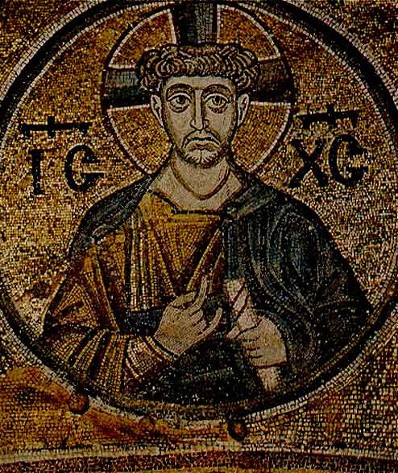
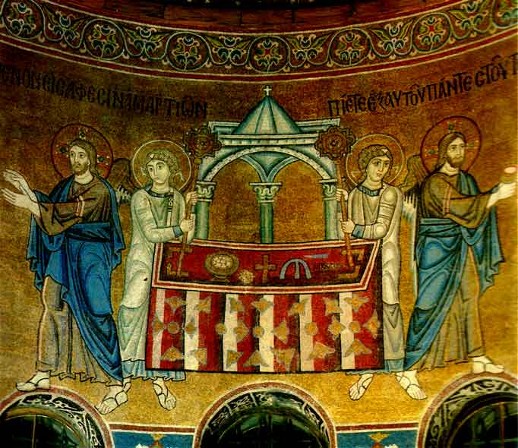
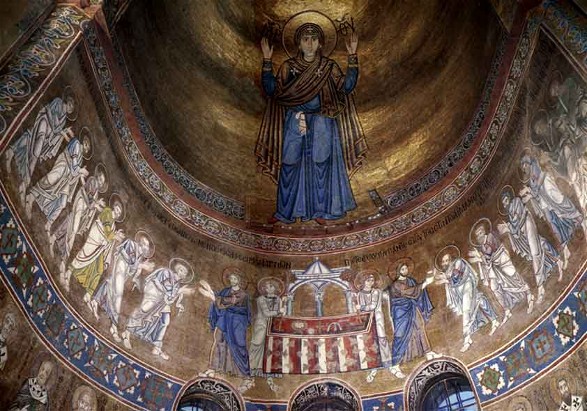
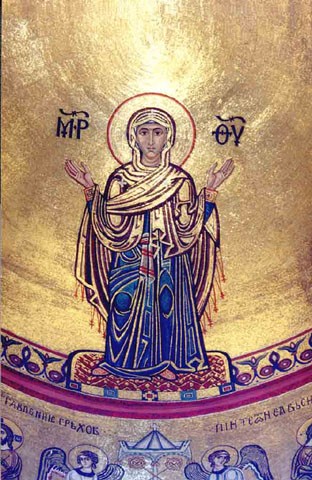
.jpg)
%20interior.jpg)
